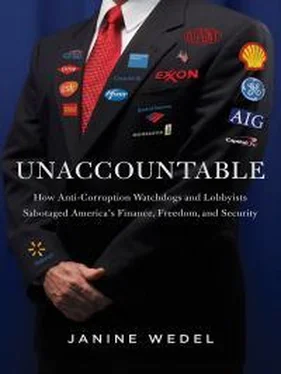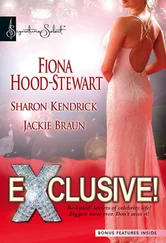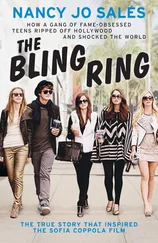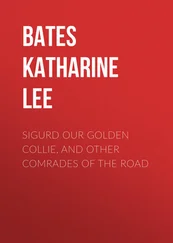47. See: http://www.newyorker.com/online/blogs/johncassidy/2013/01/send-mary-jo-white-to-justice-not-the-sec.html.
For a description of some of Mary Jo White’s white-collar crime work, see: “Mary Jo White: White Knight.” Columbia Law School Magazine, Winter 2010 (http://www.law.columbia.edu/magazine/5361/mary-jo-white).
48. Nicholas Lemann, “Street Cop.” The New Yorker, November 11, 2013 (http://www.newyorker.com/reporting/2013/11/11/131111fa_fact_lemann).
49. Ibid.
50. Gary Rivlin, “How Wall Street Defanged Dodd-Frank.” The Nation , April 30, 2013 (http://www.thenation.com/article/174113/how-wall-street-defanged-dodd-frank).
51. Mary Walton, “Investigative Shortfall.” American Journalism Review, September 2010 (http://www.ajr.org/Article.asp?id=4904). It is worth noting that Walton’s extensive report was aided by a grant from a philanthropic nonprofit: the Open Society Institute, founded and chaired by billionaire investor George Soros.
52. With that caveat in mind, figures from Investigative Reporters and Editors, the professional association that most such American journalists belong to, show that its membership plunged from 5,000 in 2005 to 3,400 in 2009 (Ken Doctor, “The newsonomics of going deeper.” Nieman Journalism Lab, November 29, 2012 [http://www.niemanlab.org/2012/11/the-newsonomics-of-going-deeper/]). By 2012, it had bumped back up to 4,300 after an aggressive outreach effort (Mary Walton, op. cit.).
53. The 2010 Pew “State of the Media” report (http://stateofthemedia.org/2010/).
54. Pew Research Center, “Overview: The State of News Media 2013,” An Annual Report on American Journalism, Pew Research Center’s Project for Excellence in Journalism, 2013, p. 3, http://stateofthemedia.org/files/2013/08/SOTNM-low-rez-pdf.pdf
55. Ibid., pp. 3-4.
56. The number of people surveyed was 595. Robert Hodierne, “Is There Life After Newspapers?” American Journalism Review , February/March 2009 (http://www.ajr.org/article.asp?id=4679).
57. Rosanna Fiske, “Why journalists don’t always make the best PR pros.” Poynter, August 15, 2011 (http://www.poynter.org/latest-news/top-stories/142682/why-journalists-dont-always-make-the-best-pr-pros/). In addition to serving as chair and CEO of the Public Relations Society of America until 2011, the article the chairwoman wrote has this additional tag line: “She is also program director of the Global Strategic Communications master’s program in the School of Journalism and Mass Communication at Florida International University in Miami.”
58. John Sullivan, “PR Industry Fills Vacuum Left by Shrinking Newsrooms.” ProPublica, co-published with Columbia Journalism Review , May 1, 2011 (http://www.propublica.org/article/pr-industry-fills-vacuum-left-by-shrinking-newsrooms).
59. Robert Waterman McChesney and John Nichols, The Death and Life of American Journalism: The Media Revolution that Will Begin the World Again. New York: Nation Books, 2010.
60. John Sullivan, op. cit.
61. See, for example, Richard W. Pollay, “Propaganda, Puffing and the Public Interest: The Scientific Smoke Screen for Cigarettes.” Public Relations Review, vol. 16, no. 3, 1990, pp. 39-54 (http://works.bepress.com/richard_pollay/22).
62. Hawley talked to marketing strategist David Meerman Scott on his blog Web Ink Now. David Meerman Scott, “How Raytheon Implemented a Brand Journalism Approach to Content Marketing.” WebIncNow , April 10, 2013 (http://www.webinknow.com/2013/04/how-raytheon-implemented-a-brand-journalism-approach-to-content-marketing.html). Raytheon’s news-like company website is at: http://www.raytheon.com/.
63. David Meerman Scott, op. cit.
64. Jeff Sonderman, “What the Forbes model of contributed content means for journalism.” Poynter, May 29, 2012 (http://www.poynter.org/latest-news/top-stories/173743/what-the-forbes-model-of-contributed-content-means-for-journalism/).
65. He started at Public Strategies in April 2009. See: “Richard Wolffe, MSNBC Political Analyst,” October 1, 2009 (http://www.nbcnews.com/id/33123380/ns/msnbc_tv-meet_the_faces_of_msnbc/t/richard-wolffe/#.Uu_oOvlkSSo).
Glenn Greenwald exposed this. See: Glenn Greenwald, “GE’s Silencing of Olbermann and MSNBC’s Sleazy Use of Richard Wolffe: Two new major MSNBC scandals reveal much about how corporate journalism functions.” Salon , August 1, 2009 (http://www.salon.com/2009/08/01/ge/). See also: Zachary Roth, “Richard Wolffe’s Two Hats: MSNBC Host and Corporate Spin-Meister.” Talking Points Memo , August 3, 2009 (http://tpmmuckraker.talkingpointsmemo.com/2009/08/richard_wolffes_two_hats_msnbc_guest_host_and_corp.php).
66. Noah Shachtman, “Think-Tanks and the Reporters Who Heart Them.” Danger Room, Wired.com, December 18, 2009 (http://www.wired.com/dangerroom/2009/12/think-tanks-and-the-reporters-who-heart-them/).
67. Nathan Hodge, “Danger, Brookings Institution!,” Danger Room, Wired.com, May 28, 2010 (http://www.wired.com/dangerroom/2010/05/danger-brookings-institution/).
68. The former FCC commissioner is Michael Copps. The relative size of Comcast is discussed here: Yinka Adegoke and Dan Levine (reporting) and Eric Beech (editing), “Comcast completes NBC Universal merger.” Reuters, January 29, 2011 (http://www.reuters.com/article/2011/01/29/us-comcast-nbc-idUSTRE70S2WZ20110129).
69. Bill Moyers, “Former FCC Commissioner: Big Media Dumbs Down Democracy.” Moyers & Company, December 4, 2012 (http://billmoyers.com/2012/12/04/former-fcc-commissioner-michael-copps-on-the-past-and-future-of-news/).
70. Interview can be found here on Gawker: Michelle Dean, “Is The Internet Making Us More Unequal? A Q&A with Astra Taylor.” Gawker, April 15, 2014 (http://gawker.com/is-the-internet-making-us-more-unequal-a-q-a-with-astr-1563177911). Her book is: Astra Taylor, The People’s Platform: Taking Back Power and Culture in the Digital Age . New York: Metropolitan Books, Henry Holt and Company, 2014.
71. Jon Russell, “The Intercept, the first online publication from eBay founder Pierre Omidyar, is now live.” The Next Web, February 10, 2014 (http://thenextweb.com/media/2014/02/10/the-intercept-the-first-online-publication-from-ebay-founder-pierre-omidyar-is-now-live/).
72. “Philanthro-Journalism: Reporters Without Orders: Can journalism funded by private generosity compensate for the decline of the commercial kind?” The Economist, June 9, 2012 (http://www.economist.com/node/21556568).
73. Mary Walton, “The Non-Profit Explosion.” American Journalism Review , September 2010 (http://www.ajr.org/article.asp?id=4906).
74. See: Michael Moss and Geraldine Fabrikant, “Once Trusted Mortgage Pioneers, Now Scrutinized,” New York Times , December 24, 2008, http://www.nytimes.com/2008/12/25/business/25sandler.html?adxnnl=1&adxnnlx=1268665238-lSuHK+lZW7SAGIrmY7lNPA; and Jeff Horwitz, “The Education of Herb and Marion Sandler,” Columbia Journalism Review , March 18, 2010, http://www.cjr.org/feature/the_education_of_herb_and_marion.php?page=all
75. Jack Shafer, “Non-Profit Journalism Comes at a Cost.” Slate , September 30, 2009 (http://www.slate.com/articles/news_and_politics/press_box/2009/09/nonprofit_journalism_comes_at_a_cost.html).
76. Jesse Holcomb, Tom Rosenstiel, Amy Mitchell, Kevin Caldwell, Tricia Sartor, and Nancy Vogt, “Assessing a New Landscape in Journalism.” Non-Profit News, Pew Research Journalism Project, July 18, 2011, p. 1 (http://www.journalism.org/2011/07/18/non-profit-news/).
77. The original Washington Post article is here: Elaine S. Povich and Eric Pianin, “Support grows for tackling nation’s debt,” Washington Post , December 31, 2009, http://www.washingtonpost.com/wp-dyn/content/article/2009/12/30/AR2009123002576.html. This article discusses the Post ’s defense: Richard Pérez-Peña, “Sourcing of Article Awkward for Paper,” New York Times , January 5, 2010, http://www.nytimes.com/2010/01/06/business/media/06post.html
Читать дальше












